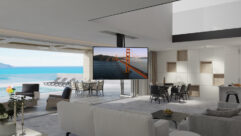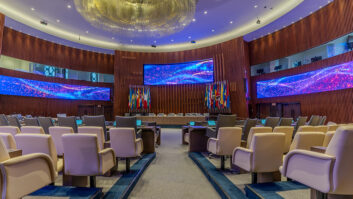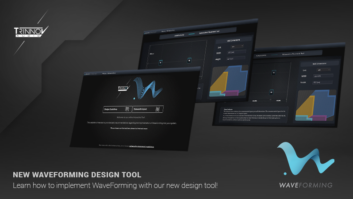
Installation Profile: Found in Translation
Jan 1, 2004 12:00 PM,
By Tom Dambly

Imagine the task of translating a book into thousands of differentlanguages, many of which do not yet exist in written form. Next,imagine explaining that project to a diverse audience that spansnationalities and generations. Because language itself is the subject,communicating the process of translation presents a uniquechallenge.
Wycliffe International, an organization whose mission is tofacilitate the translation of the New Testament into nearly 3,000languages, is meeting that challenge with the WordSpring DiscoveryCenter in Orlando, Florida. The 4,500-square-foot visitor center tellsthe story of the Wycliffe mission in text, sound, pictures, video, andinteractive computer media.Concept and planning of WordSpring was carried out by a team ofdesigners from the Wycliffe U.S. headquarters; Lorenc and Yoo Design ofRoswell, Georgia; and the Platt Design Group of Sierra Madre,California. The team collaborated on the content development, exhibitdesign, and audiovisual specifications to ensure a unified narrativefor the center. Starting with a master plan to build out to 20,000square feet in two phases, the team roughed out an overall design withthe whole story of the organization in mind. Work then began on PhaseI, culminating in the current installation. Fabrication was by 1220Exhibits of Orlando.“This was a fairly complicated story to fit into 4,500square feet,” says Jan Lorenc, design director for the project.“We had to design the space so that visitors would naturallytravel on a definite path through it. We wanted the environment toreveal the narrative piece by piece and not give away the whole storywhen visitors first came into the center. Lighting, video, and sounddesign played a key role in defining that environment.”MASS APPEALBecause the purpose of WordSpring is not only to inform visitors butalso to inspire them to participate in the organization’s mission, themandate was to develop a visual and auditory approach that communicatesintellectually and emotionally. The design team worked in concert tobuild a symbolic representation of Wycliffe’s message into theexhibits. Contrasts in color and lighting are used to support themetaphor of illumination, audio presentation of Bible verses in worldlanguages allude to the power of the word, and dynamic text displayssuggest that the scripture and its message are living entities.Accessibility was a guiding principle in the planning of the center.“An important design goal was to cover the whole spectrum oflearning styles — visual, auditory, and tactile — so wecould speak to the widest possible audience,” says MichaelCurrier, general manager of the center and project manager for itsconstruction.“We wanted to have exhibits that would appeal to all ages,with hands-on experiences for young children, interactive media forolder children, and compelling content to keep adults engaged,”Currier says. Accommodating seniors and disabled visitors was also apriority. “We also worked to be compliant with ADAspecifications, so that all of the parts of the exhibit, including anyinteractive portions, would be accessible from a wheelchair,” hesays.MUCH SOUND, LITTLE FURYSeveral design requirements for the center emerged as theaudiovisual elements of the exhibits were conceived. With its limitedsquare footage, by far the greatest challenge in designing and buildingWordSpring was acoustic isolation. With the many examples of spokenword in the center’s exhibits, clear and intelligible sound wasespecially important. “Good isolation was crucial in making thespace focusable and was necessary to keep visitors from gettingdistracted by nearby exhibits,” says Lorenc.Architecturally, many of the exhibits were designed to be evocativeof the third-world environment where much of the organization’s work iscarried out. Open wood slats, adobe, and corrugated metal constructiononly compounded the challenge of acoustic isolation andintelligibility. Bill Platt, president of the Platt Design Group andcreative director for the project, says, “We found creative waysto integrate acoustical materials into the construction of exhibitsand, wherever we could, used speakers with highly focused patterns.Where this wasn’t possible, we used headphones.”Another requirement was to make all of the center’s audiovisualequipment easy to manage. “The control system for WordSpring wasdesigned to make its operation as self-contained as possible, since thecenter doesn’t have a large staff,” says Roger Smith of the PlattDesign Group and control systems designer for the project. All videoand audio components of the exhibits, with the exception of thetheater, are connected to an AMX NetLinx system that includes an NXIintegrated controller and several hubs.The AMX system, audiovisual playback equipment, lighting controls,and the computer for the interactive displays are all located in acentral equipment room. The AMX system interfaces with the audioplayback system through MIDI and with the lighting dimmer rack via DMX.“AMX can be operated from a Web-based interface, so we createdmaintenance and control pages that allow everything in the center to beturned on or off from the computer at the front desk,” saysSmith.In the morning, an hour before people arrive, the centerautomatically powers up. An hour after the center closes, thetheatrical lighting, sound playback units, DVD players, plasma screen,and projectors all shut off automatically. “The nice thing aboutit is that it all just works,” Smith says. “Even if thereis a power interruption, the AMX system wakes up and returns the centerto the appropriate state when power is restored.”The front-desk controls also allow for quick adjustment of audiolevels throughout the center. On most days, the center typically has ahandful of people in the facility at any given time, but it also hasschool presentations, tour groups, and special events that can fill upthe center quickly. To compensate for the increased crowd noise, thegeneral volume of all of the audio playback systems can be raised fromthe AMX Web interface. As part of the automatic shutdown sequence,levels are returned to their default values for the next day.ILLUMINATING A MANUSCRIPTThe WordSpring center has one large door that serves as both themain entry and exit, so it was especially important to guide visitorson the correct path through the center. The focal point of the entranceis a large glass sculpture of a book set on a rock, with Biblical textprojected on the pages of the book from below. Envisioned early on asemblematic of the organization and its mission, the book sculptureproved to be one of the most difficult exhibits to construct.“The bible display was made of two large curved sections of¾-inch glass,” says Platt. “To get the projectionsurface on the back of the glass, we had it sandblasted to atranslucent texture that would diffuse the light properly and result ina clear image on the top surface.” Platt worked with the glassmanufacturer to find the sandblasting grain size that yielded the bestimage.The projector setup posed some challenges. “The pit under theBible display was only about three feet deep — we were limited bythe water table in how far down we could dig — and its platformwas just two feet high, so we didn’t have enough distance to projectstraight up onto the glass,” Platt says. The team made astainless steel frame that suspended a Mitsubishi X409U digitalprojector and a custom-built system of mirrors at the proper angles,compensating for the fact that the book itself was going to be set upon a slight incline.“We also had safety issues to consider,” Platt says.“Because it was going to support a couple of 200-pound pieces ofglass that people would be leaning on, the frame had to be very rigidand it had to precisely match the curvature of the glass.” Theconstruction team learned that it was difficult to account for theexpansion and contraction that occurred while making the glass; onepiece had to be remanufactured when it didn’t quite fit the frame.Once the glass was installed and the team could test the projectionsurface, some further adjustments had to be made to regulate the image.“To compensate for the curved surface of the glass, we workedwith the Wycliffe production staff, using Adobe After Effects softwareto morph the video projections.” The final sequence was burned toDVD and is played back from a dedicated Pioneer V7400 industrial DVDplayer. “This display took the coordinated effort of a lot ofdifferent groups in the project, and it turned out very well,”Platt says.To promote the theme of the Bible as a living text, its video systemwas set up to respond visitors entering the display. “Instead ofjust running a looping presentation, we settled on an arrangement oftwo motion sensors out in the lobby,” Currier says. “Whenthey are triggered by someone approaching the sculpture, the ambientmusic playback changes, and the Bible video starts up to welcome themto the center.” Playback of the video sequences is controlled bythe center’s AMX system. The center’s background audio is played from aRichmond Sound Design AudioBox AB1616HD through a series of Tannoy i8AWand i5AW speakers.VOICES FROM AROUND THE WORLDEmerging from the Bible sculpture, a series of ribbonlike woodenarches extends over the visitor’s heads, drawing their attention to agallery of ten sculpted human figures, dressed in traditional costumesof their region, representing different language groups. The ribbonsare covered with streams of words that connect to the figure for thecorresponding language group.Each figure in turn has a Bible verse associated with it. A recordedversion of the verse is triggered from a button on the panel in frontof each figure and played on one of five overhead speakers.“Because the figures are so close together, we chose to have onesound dome for every two figures and programmed the AMX system tocontrol playback so that only one of the recordings on a shared domecould play at a time,” Platt says. Playback is from an additionalAudioBox with individual outputs to each of the SoundTube FP633parabolic speaker domes. Custom Idec buttons on the panels illuminatewhen a figure is ready to play back and flash when a figure is lockedout.“The isolation between domes was very good, but we had tocompensate for the sonic characteristics of the domes themselves, asthere was some comb filtering going on,” Platt says. A MeyerSound SIM II system was used to determine the EQ needed to give thematerial a flatter and more natural-sounding response. “Weapplied some processing in the studio, and then to fine-tune eachrecording, we applied additional processing in the playback system. Wewere able to work it out so that all the domes could be playing back atthe same time and you could hear the individual messages undereach.” All audio connections in the center were made withWhirlwind custom panels and connectors.THEATER UNDER THE STARSAt the end of the entrance gallery, visitors encounter the circularTownsend theater, a 30-person space designed for video, slidepresentations, and lectures. Third-world materials and audiovisualequipment are integrated in the venue: the projection screen is flankedby stacked fieldstone and oak-plank benches and walls and capped by astylized world map graphic that evokes the night sky. Isolation wallsare built into the curved walls of the theater.The theater features several films created at Wycliffe’s mediaproduction center. “We can run a number of different shows inthere very easily, and we also have field staff who will come and dopresentations, often with their own videos or PowerPoint slides,”says Currier.The main projector in the theater is a Mitsubishi XL30U, with videoinputs switchable between a second Pioneer DVD-V7400 DVD player, a VHSdeck, and an auxiliary input for sources such as a laptop computer.Audio playback is through a Meyer Sound 5.1 surround system, consistingof five UPM-1Ps and a UMS-1P subwoofer. A B&K Components 5.1theater sound processor handles the surround channels and bassmanagement.A dedicated AMX panel in the theater provides control of thelighting, video input, and audio routing. The theater’s DVD playercontrols are set up so that the center staff can quickly switch betweenversions of Wycliffe’s introductory DVD in English, Spanish, or Korean.The theater lighting is programmed to respond to a chapter break on theDVD where the credits begin so that the lights automatically start tocome up as the credits roll on the screen.FROM DARKNESS TO LIGHTThe next area in the center takes the visitors on a metaphoricaljourney using light and sound to illustrate the transformative power ofscripture. Lighting controls for the center include a Colortran i48eDMX dimmer rack and a Leprecon LP-1524 programmable console. Lightingdesign for the center was carried out by Stefan Graf for the PlattDesign Group.Designed to convey a sense of desolation, the Life Without the Bibleexhibit is a tall, narrow room, about 10 feet square at the base, withthe walls tapering up to a narrow ceiling panel and a barred window atthe top.Visitors press a start button on the outside of the room, beginninga short voice-over that invites them inside. Once the visitors haveentered the space, the ambient lights go down, and a single spotlightshines down through the bars. Then, the spotlight is extinguished, andan audio program begins in darkness. As the narration continues, largephotographs of people, extending up three of the walls, are spotlightedas their voices are played back.“The message for this display was complicated, as we had a lotof different recordings from people all over the world,” saysPlatt. Because of the shape of the room, there was no way to messagesound from particular locations and locate the voices with theircorresponding pictures. “The acoustics of a tall room with hardwalls are very live, so I chose a single Tannoy T12 coaxial speakerpointing down from the ceiling. The point source with conical coveragehelped ensure intelligibility of the voices in that space,” saysPlatt.Because it was already set up to control other lights in the center,the AMX system did not have enough onboard dimmer channels to bring upthe lights on each picture as their voices were playing, so a box ofadditional AMX-compatible relays was installed in the room. The remoterelays are then controlled from the AMX system through a proprietaryEthernet network and timed to match playback of the audio program.A water well with a sculpted scroll manuscript, representing theflow of Bible translation from ancient to modern languages, introducesthe next area. In stark contrast to the darkness of the adobe tower,this space is ringed by softly illuminated exhibits where visitors canexplore the history of the Bible and its translation in a variety ofinteractive displays.A white wall with a supergraphic of scripture in various languagesis the background to sections of canvas lit with white light. In frontof those canvas sections is a series of interactive panels, each withvideo and audio content triggered by the visitor. The center of thisarea is designed for children, with hands-on displays and video andaudio interactive stations. Throughout the center, interactive kiosksuse dedicated Samsung 15-inch LCD screens and custom trackballs andswitches from Happ Controls. Audio examples in these and otherinteractive exhibits in the center are played over Sennheiser HD470headphones.THE LANGUAGE TREEThe next major area of the center is designed to convey the richnessand variety of the many living languages Wycliffe encounters in itswork. Its centerpiece is a large tree with thousands of wooden leaves,each representing one language; color coding indicates which languageshave Bible translations. Continuing the third-world theme, theperimeter of the exhibit uses basic materials such as corrugated metal,concrete blocks with oozing mortar, and natural wood.Directly beneath the language tree are several computer consoleswhere visitors can type in their name and view it in 12 differentalphabets. The interactive computers at WordSpring use Avocent LongViewCompanion keyboard and monitor extenders.Exhibits around the perimeter of the tree offer audio examples oflanguages recorded by Wycliffe. A series of hands-on displaysillustrates the relationship of language to culture. Around the corner,a digital photo kiosk lets visitors take their own picture, drop itinto background photos from distant field locations, and send it as ane-mail postcard.In order to have e-mail capability for the digital postcard exhibitand to run other Web-based features on the computers, the centerrequired Internet access. “Instead of just connecting to thenetwork for the entire complex, Wycliffe’s IT department built aseparate firewalled branch of their Ethernet network forWordSpring,” Smith says. “We then tied into that network toprovide the Web-based AMX controls at the front desk.”TRANSLATION CHALLENGESThe history and methods of the modern translation movement are thesubject of the next area, where a wall of interactive panelsillustrates aspects of the research process, the development of writingsystems, and the promotion of literacy. In the middle of this area,three computer consoles run interactive titles developed at Wycliffe.Booklike narratives provide insight into the challenges of translatingthe Bible by taking the visitor through real-world scenarios.“About half of the media content was developed completely byour in-house staff, and the rest was developed under direction of ourcommunications department, which includes staff photographers; a video,audio, and post-production facility; computer interactive designers;and a staff of writers and editors,” says Currier. Mediadeveloper Craig Duddles and media coordinator Heather Guiney workedwith the design team to develop interactive content for the displaysand exhibits in the center.Just beyond the translation area, a kiosk of woven wood, known asthe DVD hut, shows short videos produced by the Wycliffe media team.Visitors can choose which of 12 programs to play with a customfive-button interface that allows navigation of the DVD menu. The openconstruction of the hut presented acoustic isolation problems.“We put four overhead Tannoys close to the seating positions inthe hut so that when visitors sit down, they are only a couple of feetaway from a speaker,” says Platt.Even with the directed sound inside the hut, there was still thepossibility that it might disrupt other exhibits, so it was decidedthat volume would be controlled remotely. “Rather than givepeople in the hut the option of controlling the playback volume,”says Smith, “we take the audio signal coming from the DVD playerat line level, run it to an amplifier that is controlled remotely fromthe AMX interface, then send it back to the speakers in the hut.”The center staff can then control levels from the front desk, alongwith the audio for other exhibits.LOOKING AHEADThe final stop at the center invites visitors to partner with theorganization. A 50-inch Samsung PPM50HT plasma-screen display shows anin-house video production. Three computer consoles allow people to viewthe center’s Web site and match their interests and skills withopportunities at Wycliffe.In planning the center’s Phase II expansion, the team is looking toincrease the multimedia content of the exhibits, which has proven to bepopular. “Because of the technology involved — in thecomputer interactive parts as well as the audio presentations —we find that kids are very much engaged,” says Currier. If theWordSpring message compels the next generation to get involved, thatspeaks well for the future of Wycliffe’s mission.Tom Damblyis a freelance writer and musician in the SanFrancisco Bay Area.For More InformationAdobe Systems
www.adobe.comAMX
www.amx.comAvocent
www.avocent.comB&K Components
www.bkcomp.comColortran
www.colortran.comHapp Controls
www.happcontrols.comIdec
www.idec.comLeprecon
www.leprecon.comLorenc and Yoo Design
www.lorencyoodesign.comMeyer Sound
www.meyersound.comMitsubishi Electric US
www.mitsubishielectric.comPlatt Design Group
www.plattdesign.comPioneer Electronics
www.pioneerelectronics.comRichmond Sound Design
www.show-control.comSamsung
www.samsung.comSennheiser
www.sennheiserusa.comSoundTube Entertainment
www.soundtube.comTannoy
www.tannoy.comWhirlwind
www.whirlwindusa.com









